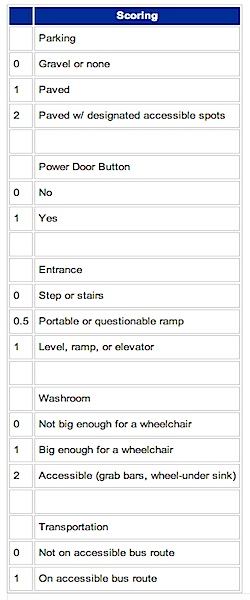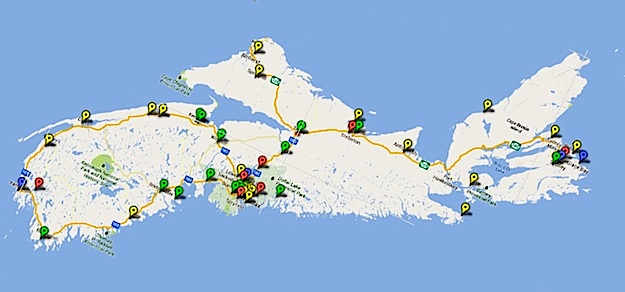05 Jun Does your MLA serve citizens in wheelchairs?
The James McGregor Stewart Society, a small voluntary group with a single summer intern, has managed to pull off in a month what the Disabled Persons Commission of NS (annual budget: $600,000) and the Nova Scotia Human Rights Commission ($2.1 million) have not achieved in the decades of their existence.
It has surveyed the accessibility of MLAs offices throughout the province. The results will not be a source of pride for Nova Scotia or its legislators.
 The survey rated MLAs’ constituency offices based on parking facilities, power door buttons, entrance accessibility, washroom accessibility, and proximity to accessible bus routes. Since accessible bus routes are mostly beyond an MLA’s control (many ridings have none), that category was not included in the final ratings.
The survey rated MLAs’ constituency offices based on parking facilities, power door buttons, entrance accessibility, washroom accessibility, and proximity to accessible bus routes. Since accessible bus routes are mostly beyond an MLA’s control (many ridings have none), that category was not included in the final ratings.
Only four MLAs (Lenore Zann, Eddie Orrell, Kelly Regan, and Graham Steele) got a perfect score: paved parking with designated accesible spaces; level entrance, satisfactory ramp, or elevator; power door button; accessible bathroom with grab bars and wheel-under sink).
One MLA, Chris D’Entremont, who represents Argyle and sits on the Management Commission that will decide whether accessibility will be a condition for reimbursement of office expenses, scored a perfect zero. His office has no paved parking, no designated parking spaces, no level entrance, and no accessible washroom.
Although 43 MLAs claim an accessible doorway, only eight have a power door button, which means a constituent in a wheelchair can get in only if someone assists them. Once inside, wheelchair-using constituents will find only eight offices with fully accessible washrooms. How confidently could you attend a meeting knowing you would would have no chance to pee until you got home? You certainly couldn’t hold a job in such an office.
Another 30 MLAs claim some level of washroom accessibility, but lack grab bars, a wheel-under sink, or a high toilet. This translates as: Use at your own risk of accident or humiliation.
The survey turned up fewer regional variations than you might expect. The average MLA scored 3.1 points. Urban MLAs averaged 3.3, while rural MLAs averaged 2.9.
Metro MLAs averaged 3.2; Cape Breton MLAs just 2.4.
Liberal MLAs had the best score: an average of 3.5 points. PCs averaged 3.0, and the NDP trailed the pack with an average 2.9 points.
Two MLAs, Percy Paris and Geoff MacLellan, have not yet completed the survey. Cape Breton South is vacant.
Perhaps the most telling statistic is this: The eight MLAs who sit on the House of Assembly Management Commission, the body currently deciding whether to require accessibility as a condition of expense reimbursement, have an average score of just 2.3 — the lowest of any group I checked.
 Speaker Gordie Gosse, who chairs the committee, has a double distinction: His constituency office and his office in the legislature are both inaccessible to people in wheelchairs.
Speaker Gordie Gosse, who chairs the committee, has a double distinction: His constituency office and his office in the legislature are both inaccessible to people in wheelchairs.
Clicking on the image at the top of this post will bring up an interactive map of Nova Scotia with a colored marker for each constituency office. Clicking on a marker will bring up accessibility details for that office.
Please note that the map and the data underlying it are works in progress. Some MLAs continue to provide new information, and the society’s intern, the redoubtable Kelly McKenna, is updating it continually. The information in this post is up to date to the best of my knowledge, but it’s a lot of information, and there could be minor errors.

